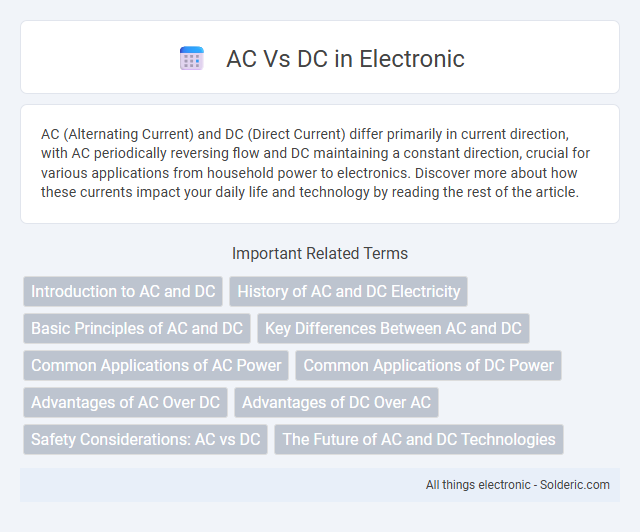AC (Alternating Current) and DC (Direct Current) differ primarily in current direction, with AC periodically reversing flow and DC maintaining a constant direction, crucial for various applications from household power to electronics. Discover more about how these currents impact your daily life and technology by reading the rest of the article.
Comparison Table
| Feature | Alternating Current (AC) | Direct Current (DC) |
|---|---|---|
| Definition | Electric current that reverses direction periodically | Electric current flowing in a single direction |
| Voltage Type | Alternates between positive and negative | Maintains constant polarity |
| Frequency | Standard frequencies: 50Hz or 60Hz | Frequency is zero (constant flow) |
| Common Uses | Power distribution, household electricity | Electronics, batteries, DC motors |
| Transmission Efficiency | Efficient over long distances via transformers | Less efficient for long-distance transmission |
| Generation Sources | Generators, power plants | Batteries, solar cells, fuel cells |
| Conversion | Can be converted to DC using rectifiers | Can be converted to AC using inverters |
| Safety | Generally less hazardous at high voltages due to zero crossing | More hazardous at low voltages due to steady current flow |
Introduction to AC and DC
Alternating Current (AC) and Direct Current (DC) are two fundamental types of electrical current used in power systems and electronic devices. AC periodically reverses direction, making it ideal for efficient transmission over long distances, while DC flows consistently in one direction, commonly used in batteries and electronic circuits. Understanding the differences between AC and DC helps optimize your electrical applications for performance and safety.
History of AC and DC Electricity
The history of AC and DC electricity dates back to the late 19th century, with Thomas Edison pioneering direct current (DC) systems for early electrical power distribution. Nikola Tesla and George Westinghouse developed alternating current (AC) technology, which enabled efficient long-distance power transmission due to its ability to easily change voltage with transformers. Your understanding of electrical systems benefits from knowing that AC ultimately became the dominant system for modern power grids because of these technological advantages.
Basic Principles of AC and DC
Alternating Current (AC) involves the flow of electric charge that periodically reverses direction, typically represented by a sine wave in voltage and current over time. Direct Current (DC) features a unidirectional flow of electric charge, maintaining a constant polarity and magnitude. The fundamental difference between AC and DC lies in their voltage and current behavior, influencing applications such as power transmission for AC and battery-operated devices for DC.
Key Differences Between AC and DC
AC (Alternating Current) periodically reverses direction while DC (Direct Current) flows consistently in one direction. AC is widely used for power transmission over long distances due to its ability to easily transform voltage levels with transformers, whereas DC is commonly utilized in battery-powered devices and electronic circuits for stable and constant voltage supply. AC frequency is typically 50 or 60 Hz depending on the region, while DC has zero frequency as it is unidirectional.
Common Applications of AC Power
AC power is predominantly used in residential and commercial buildings for lighting, heating, and powering household appliances due to its efficient transmission over long distances. Industrial machinery and electric motors frequently rely on AC for variable speed control and energy efficiency. Utility companies generate and distribute AC electricity because transformers enable easy voltage stepping, optimizing power delivery across extensive grids.
Common Applications of DC Power
DC power is widely used in battery-operated devices such as smartphones, laptops, and electric vehicles due to its stable voltage supply. It powers electronic systems in computers, LED lighting, and solar panels, where consistent direct current is essential. Your renewable energy setup or portable electronics rely on DC for efficient energy storage and operation.
Advantages of AC Over DC
AC (Alternating Current) offers greater efficiency in power transmission over long distances due to its ability to easily transform voltage levels using transformers, reducing energy loss. This makes AC more cost-effective and adaptable for widespread electrical grid distribution compared to DC (Direct Current). By choosing AC systems, Your infrastructure benefits from established technology that supports reliable, scalable, and flexible energy delivery.
Advantages of DC Over AC
Direct current (DC) offers superior efficiency in electronic devices and battery-powered systems due to its stable voltage and consistent polarity, reducing energy loss during transmission and conversion. DC enables simpler integration with renewable energy sources like solar panels and energy storage systems, enhancing overall sustainability. Moreover, DC is ideal for precise control in applications such as electric vehicles and industrial electronics, where consistent power supply improves performance and reliability.
Safety Considerations: AC vs DC
AC (Alternating Current) poses higher risks of electric shock due to its continuous polarity change, which can interfere with the heart's rhythm and cause ventricular fibrillation more easily than DC (Direct Current). DC provides a steady flow of current that, while potentially causing burns or muscle contractions, is less likely to induce heart arrhythmias. Safety protocols for AC systems emphasize insulation and circuit breakers, whereas DC systems require specialized equipment like DC-rated fuses and disconnect switches to manage arc suppression and reduce hazards.
The Future of AC and DC Technologies
AC and DC technologies continue to evolve, with AC dominating power transmission due to its efficient long-distance capabilities, while DC gains traction in renewable energy systems and high-voltage applications. Innovations in power electronics and grid integration enable DC to complement AC networks, enhancing energy efficiency and reliability. Your choice between AC and DC solutions will depend on the specific needs of modern electrical infrastructure and sustainable energy goals.
AC vs DC Infographic

 solderic.com
solderic.com